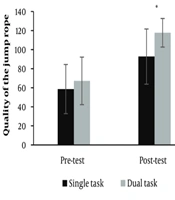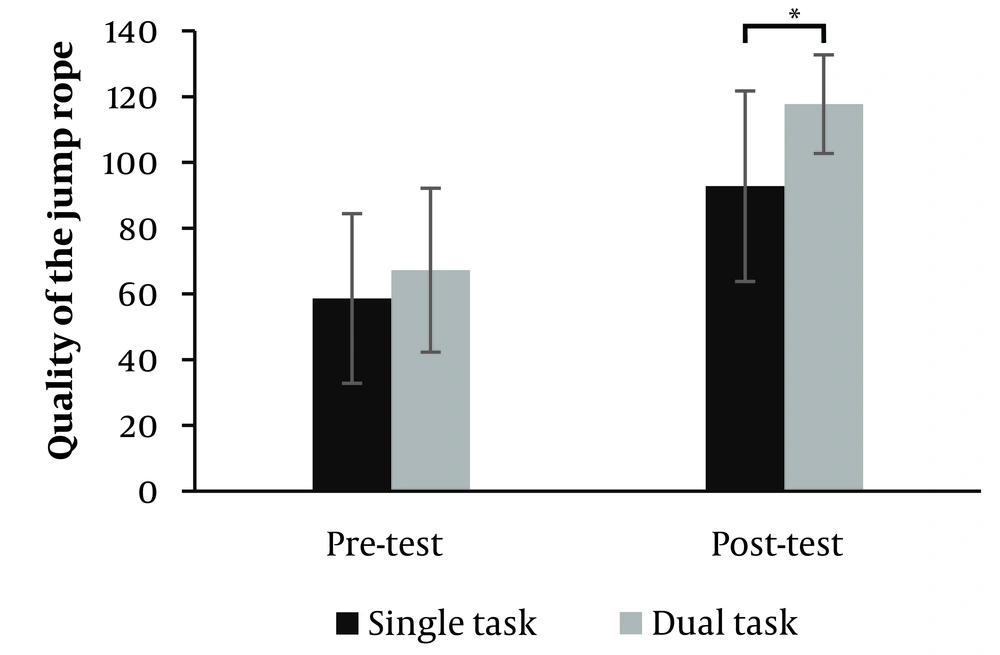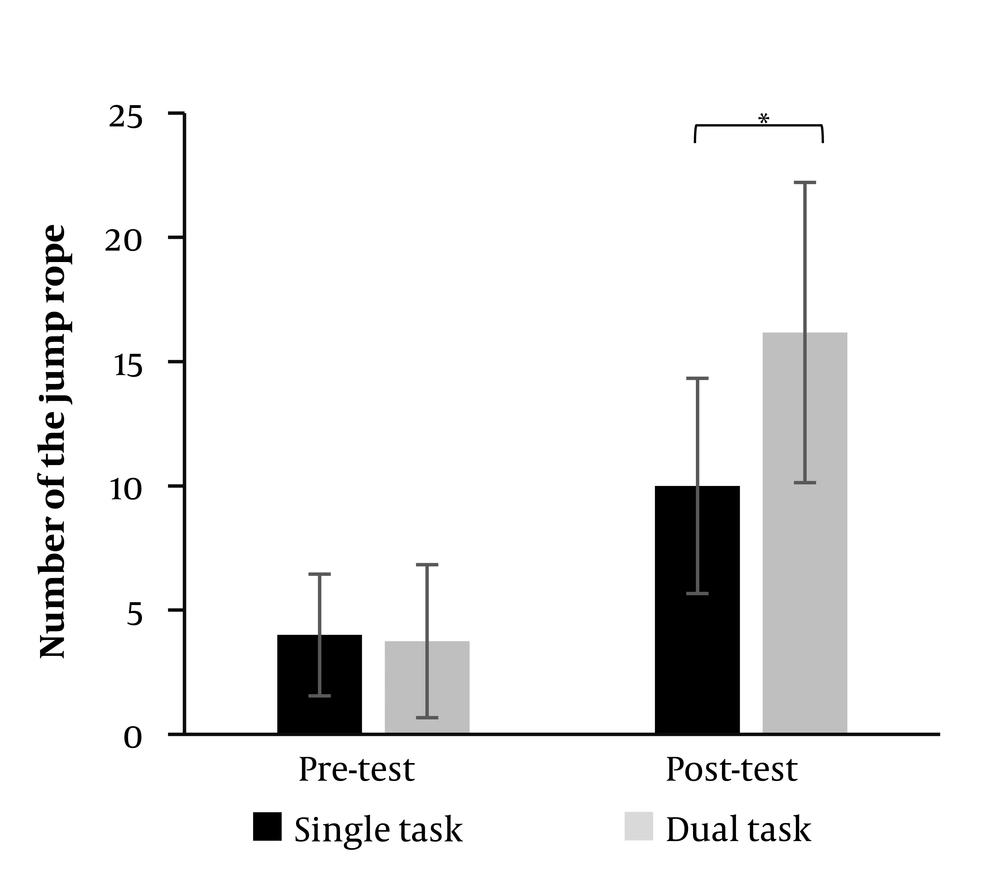1. Background
In daily life, children and adolescents often face situations that require simultaneous cognitive and motor tasks, such as navigating a crowded street or learning team sports. These multitasking scenarios can involve switching between different tasks or performing two tasks at once, like an athlete dribbling a ball while making tactical decisions. Dual-tasking paradigm refers to the ability to perform two tasks simultaneously. It’s a measure of executive function, as it requires participants to coordinate their attention to both tasks while they are being performed. Woollacott and Shumway-Cook described attention as an individual's information processing capability, stating that attention is necessary for all tasks (1). The central bottleneck theory, suggests that due to an information-processing bottleneck, only one task can be processed sequentially. This theory implies that the processing of a second task cannot begin until the first task is finished, often leading to delayed response times in dual-task (DT) scenarios (2). Resource theory suggests that when processing multiple tasks compared to a single task (ST), a certain number of resources are available for allocation (3). These resource limitations become more apparent when overall capacity is restricted, such as in novices, children, or older adults (4). Attentional control evolves dynamically from childhood through young adulthood, with distinct trajectories for different attentional functions. The prefrontal cortex and brain networks contribute significantly to this developmental process (5). Research indicates that training that combines cognitive and motor tasks (dual-tasking) can lead to greater improvements in both cognitive function and physical performance than training that focuses on either aspect alone. Hemond et al. (6) and Wollesen et al. (7) observed that DT training interventions could enhance physical functions in children and adolescents. However, they emphasized the need for additional high-quality studies to confirm these findings.
There is an increasing amount of research incorporating jump rope activities into physical education (PE) programs; however, none have yet utilized a DT methodology to examine jump rope skills.
2. Objectives
Therefore, this study aims to examine the impact of DT training on the learning of jump rope skills. The study is conducted online, with instructions delivered through mobile technology. It is important to note that this research was conducted amidst the COVID-19 outbreak and was facilitated online as schools were closed.
3. Methods
3.1. Subjects
A total of 26 students in a third-grade class were selected using a convenience sampling method, based on the research entry criteria. The entry criteria included: Third-grade girls with mobile phones and internet access, consent to participate, possession of a rope, adequate home space for exercises, and good health for physical activities.
The sample size was determined with G*POWER 3.1 software, considering a effect size = 0.7, a significance level = 0.05, a statistical power = 0.95, and involving two distinct groups (the ST and DT groups). During the research implementation, two students opted out.
3.2. Apparatus and Task
3.2.1. The Jump Rope Process Measurement Questionnaire
The Jump Rope Performance Measurement Questionnaire employed two referees to assess the participants’ jump rope skills. Scores ranged from 1 to 10, with a full score awarded for complete section execution. The reliability of the questionnaire was assessed using the Cronbach’s alpha coefficient method, which yielded a Cronbach’s alpha of 0.82.
3.2.2. 30-Seconds Jump Test
In the 30-second jump test, participants perform jump rope in place for 30 seconds. Counts are recorded each time the rope passes under the right foot. Proper form requires the feet’s soles to be hidden from view at the back, with knees slightly elevated at the front. Double jumps on one leg are counted as errors. During the test, participants aim to maximize their jump count. A partner tallies only the jumps meeting specific criteria: Both hands on the rope, a full swing over the head, and a complete jump over the moving rope. This test assesses the participants’ short-term peak performance and skill consistency (8). The reliability of the 30-second jump test was established through a test-retest analysis, yielding a Cronbach’s alpha coefficient of 0.76.
3.3. Procedure
Research participation was approved by the Department of Education, and students’ parents consented via forms. This study took place at the Elementary School in Arak city. Initially, subjects received basic jump rope skill (jogging) instruction through verbal guidance and demonstrations. Following five practice repetitions, the pre-test scores was obtained using the Jump rope process measurement questionnaire and the 30-second Jump rope speed test. Subsequently, students were randomly separated into two practice groups: Single task and DT. Students in both the ST and DT groups participated in jump rope exercises over eight weeks with two weekly sessions. The ST group received jump rope instruction through a mobile phone video and performed 30 repetitions per session. The DT group had the same setup but included a backwards counting task. The instructor sent the video via mobile phone, and participants in both groups had to go online in the virtual class group twice a week at a certain time to receive the video and instructions. Post-tests assessed the effectiveness of the training in both groups.
3.4. Data Analysis
All statistical analyzes were performed with SPSS® 26.0. The paired t-test and analysis of covariance (ANCOVA) were used to analyze the data.
4. Results
Table 1 displays the descriptive statistics for the research variables measured during the pre-test and post-test phases.
| Variables and Group | Pre-test | Post-test |
|---|---|---|
| The quality of the jump rope | ||
| ST | 58.62 ± 25.79 | 92.75 ± 28.97 |
| DT | 67.21 ± 24.92 | 117.71 ± 15.00 |
| The number of the jump rope | ||
| ST | 4.00 ± 2.45 | 10.00 ± 4.33 |
| DT | 3.75 ± 3.08 | 16.17 ± 6.04 |
Descriptive Findings Related to Indicators of Jump Rope Quality and Jump Rope Quantity a
The Shapiro-Wilk test results substantiate the normal distribution of data for both groups under study (P > 0.05).
The paired t-test indicated a significant increase from pre-test to post-test in both the quality of jump rope performance and the number of jumps in the two research groups. Significant improvements were observed in the quality of jump rope performance in both the ST group [t (11) = 4.24, P = 0.001] and the DT group [t (11) = 9.61, P = 0.001]. Similarly, there was a significant increase in the number of jump rope performances in both the ST group [t (11) = 7.34, P = 0.001] and the DT group [t (11) = 9.78, P = 0.001].
The ANCOVA results showed a significant difference between the post-test scores of the quality of the jump rope and the number of the jump rope between the groups (Table 2). Comparative analysis of the adjusted group means revealed that the DT group’s mean score for the quality of the jump rope (estimated mean = 115.64) was significantly better than ST group (estimated mean = 98.82). Also, the DT group’s mean score for the number of the jump rope (estimated mean = 16.34) was significantly better than ST group (estimated mean = 9.82) (Figures 1 and 2).
Analysis of Covariance Results
5. Discussion
This study aims to examine the impact of DT on learning jump rope skills with instructions delivered via mobile technology. We explore how DT training influences the quality of jump rope performance and the number of jumps achieved. Our findings align with previous research by Liu et al. (9) and Plummer et al. (10), as well as studies conducted by Fritz et al. (11), He et al. (12), and Azadian et al. (13). Additionally, Silsupadol et al. (14) demonstrated that DT training improves motor function. But previous studies have already indicated the effect of selective training programs under single- and DT situations on balance and walking when individuals engage in both cognitive and movement exercises simultaneously, their learning ability and memory improve. To justify the enhancement of cognitive performance following cognitive-motor DT exercises, it can be argued that these training methods involve exercises that increase flexibility and enhance concentration and attention. This exercise approach fosters harmony between the mind and body, ultimately strengthening cognitive function. In this study, Selective training programs under ST and DT conditions induce learning of jump rope skills among third-grade students. One of the reasons for this is the use of mobile technology in delivering instruction. As mentioned Layne et al. (8), students who received Sport Education with technological feedback experienced significant improvements in their jump rope performance. Today’s students enjoy the use of technology for any school-related task. Interest levels and student enjoyment may increase with this simple change. Currently, there is a push to evaluate the use of technology and its associated benefits in PE (15). The addition of technology can help inform individual and group progress, as well as motivate students to improve by tracking their performance in real time.
The other finding in this study demonstrates the superiority of DT training. Our findings align with the research by Kim and Park (16). Cognitive-physical DT training involves coordinating multiple tasks simultaneously, which is closely linked to executive function (17). Neuroimaging studies reveal that executive function heavily relies on the prefrontal cortex (18). Indeed, previous research consistently reports that DTs enhance activation in the prefrontal cortex (19), supporting the neuropsychological relationship between dual-tasking and executive function. Regarding jump rope skills, successful performance depends primarily on gross motor coordination—the ability to synchronize arm, leg, and torso movements while the entire body is in motion (20). Additionally, these combined movements require maintaining balance (postural stability) throughout the exercise to prevent inappropriate shifts in the center of gravity. Therefore, achieving proficiency in jump rope skills necessitates focused attention and concentration. Furthermore, due to its cognitive nature, DT training in this study has improved attention and, as a result, increased students’ learning of jump rope skills in third-grade students. On the other hand, according to previous research, rope training improves executive functions (21), which can have a complementary effect on cognitive tasks. In their study, Goh et al. (22) found that when two tasks engage similar processes simultaneously during practice, as indicated by a high level of DT interference, there is enhanced learning during retention. Perhaps in this study, counting while simultaneously performing jump rope skills involves similar cognitive processes. Consequently, training under DT conditions is superior to training under ST conditions.
There are a few limitations to this study, including the relatively small sample sizes. Due to the small sample sizes, the findings of this study may not be broadly applicable to larger populations. Additionally, this study was conducted on girls. It is suggested that similar studies be conducted on other sports as well as on boys. Discovering optimal methods for teaching rope skills—as a basic, useful, practical, modern, scientific, and applicable sport—is crucial for achieving the goals of PE. According to the results of this research, engaging in jumping rope exercises under DT conditions and receiving instructions via mobile phone technology can significantly enhance the learning of this skill. Considering the role of virtual education in learning, it is advisable for PE teachers to utilize virtual platforms for teaching jump rope skills, especially when schools are closed due to various weather conditions such as cold or air pollution.
Overall, the findings of this study demonstrated that both DT and ST interventions led to improvements in participants’ performance during the post-test stage. Furthermore, the study observed the superiority of DT training in enhancing jump rope skill learning among third-grade students. These results suggest that conducting jump rope exercises under DT conditions, can facilitate more effective skill learning.


